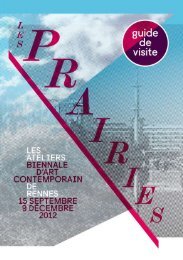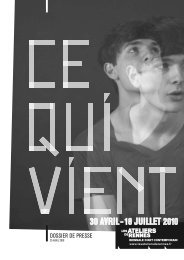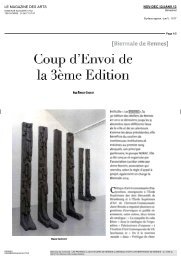Download here the Visitor's guide. - Les Ateliers de Rennes
Download here the Visitor's guide. - Les Ateliers de Rennes
Download here the Visitor's guide. - Les Ateliers de Rennes
You also want an ePaper? Increase the reach of your titles
YUMPU automatically turns print PDFs into web optimized ePapers that Google loves.
KEES GOUDZWAARD<br />
Lightweight, 2009. Courtesy galery Zeno X, Anvers.<br />
Photography : Peter Cox.<br />
SOFIA HULTéN<br />
Since moving to Berlin at <strong>the</strong> beginning of <strong>the</strong> present<br />
century, Sofia Hultén has busily honed her recycling<br />
impulses. She hunts out ready-ma<strong>de</strong> and used objects.<br />
The objects that she works on are often <strong>the</strong>mselves<br />
objects from <strong>the</strong> toolbox and provi<strong>de</strong> a first clue to <strong>the</strong><br />
conceptual nature of her work, namely her reflexivity.<br />
The vi<strong>de</strong>o Past Particles – The Found Toolbox (2010) is<br />
a meticulous inventory. She lists more than a hundred<br />
pieces of ironmongery from a found toolbox. They<br />
are all individually filmed, each fragment appearing<br />
different but giving no clue as to its use or function. The<br />
Lazy Man’s Gui<strong>de</strong> to Enlightenment is <strong>the</strong> name of an<br />
installation in which nine metal door and window grids<br />
have been sawn into three horizontal portions and each<br />
third <strong>the</strong>n sol<strong>de</strong>red on to two o<strong>the</strong>r sections to create nine<br />
new, unequal window bays, hung at regular intervals.<br />
When looked at along <strong>the</strong> axis of <strong>the</strong>ir alignment, <strong>the</strong><br />
grids seem to reappear as <strong>the</strong>y overlay one ano<strong>the</strong>r.<br />
This simultaneously multiple and unitary view is a<br />
metaphor for <strong>the</strong> alternating processes of expansion and<br />
contraction <strong>de</strong>scribed in <strong>the</strong> self-help manual that has<br />
given its name to <strong>the</strong> installation.<br />
H. M. tr. J.H.<br />
Born in 1972 in Stockholm (Sue<strong>de</strong>), lives and works in<br />
Berlin (Germany).<br />
<strong>Les</strong> Prairies's artists<br />
Kees Goudzwaard's abstract painting has been fostered by various<br />
different pictorial influences – from Dutch landscape painting to German<br />
Expressionism by way of American Color Field Painting. He uses full-size<br />
paper mock-ups to experiment with various compositions before beginning<br />
to paint on his canvas. During <strong>the</strong> 1990s, he ma<strong>de</strong> a radical change. He<br />
realized that <strong>the</strong> subject of his work was not <strong>the</strong> painted picture but<br />
<strong>the</strong> mock-up image, which preserves intact <strong>the</strong> moments of doubt and<br />
hesitation in his thought process. Like a musical score, it allows him to<br />
arrange and superimpose layers of coloured paper or sheets of transparent<br />
plastic which he fixes with adhesive tape – generally on <strong>the</strong> wall of<br />
his studio. In a second phase, he paints an exact copy of <strong>the</strong> original<br />
mock-up without, however, taking into account <strong>the</strong> reliefs and shadows.<br />
Goudzwaard insists that his work is not an illusionist trick or a trompel'oeil<br />
but simply <strong>the</strong> substitution of one reality for ano<strong>the</strong>r. He replaces <strong>the</strong><br />
reality of his painting with <strong>the</strong> reality of his process. The canvas is both <strong>the</strong><br />
mental representation of a picture to come and a completely finished work<br />
in its own right. Goudzwaard is exhibiting several pictures <strong>here</strong>, each of<br />
which addresses a particular aes<strong>the</strong>tic question. Untitled (2000) is from a<br />
period when he was thinking about Dutch Mo<strong>de</strong>rnism. He was taken with<br />
<strong>the</strong> i<strong>de</strong>a of Mo<strong>de</strong>rnism as a promise of something possible, a kind of silent<br />
euphoria, and was attempting to give it a more private dimension. "This<br />
picture is a statement of a mental space private enough for somebody to<br />
want to inhabit it and feel at home in it."<br />
F. O. tr. J.H<br />
Born 1958 in Utrecht (Ne<strong>the</strong>rlands), lives and works around<br />
Anvers (Belgium) and Reusel (Ne<strong>the</strong>rlands).<br />
Lazy Man's Gui<strong>de</strong> to Enlightenment, 2011. Installation view.<br />
Collection Konstmuseum of Malmö.<br />
49






